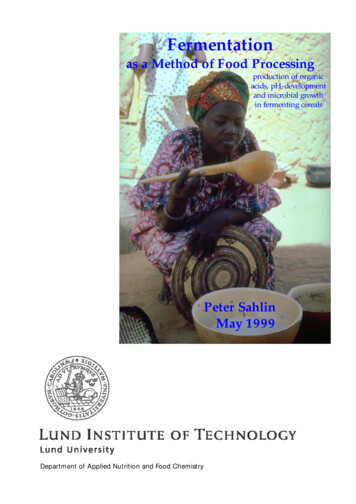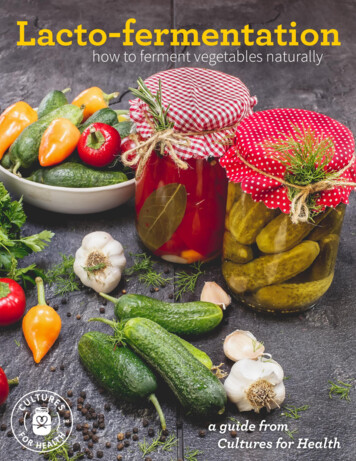
Transcription
Fermentationas a Method of Food Processingproduction of organicacids, pH-developmentand microbial growthin fermenting cerealsPeter SahlinMay 1999Department of Applied Nutrition and Food Chemistry
Fermentationas a Method of Food Processingproduction of organic acids, pH-development andmicrobial growth in fermenting cerealsLicentiate thesis May 1999Peter SahlinDivision of Applied Nutrition and Food ChemistryCenter for Chemistry and Chemical EngineeringLund Institute of TechnologyLund University
2
PrefaceIn developing countries, one tenth of the children under five years of age dies due todehydration. The dehydration is mainly caused by too many of severe incidences ofdiarrhoea. The main cause for getting diarrhoea is the ingestion of food not havingthe appropriate standard regarding the hygienic condition. The hygienic standard ofa food is based on the processing and handling of the food, as well as on theconditions of the raw materials. A food item prepared with water contaminated withpathogenic microorganisms will successively become contaminated, and a health risk.It is known that pathogenic microorganisms normally found in food will not be ableto grow in an acid environment, that is at pH below four. This acidity is normallyfound in lactic acid fermented food.This thesis deals with the production and properties of lactic acid fermented food. Atthe beginning of the fermentation step, the food is vulnerable to contamination sinceit does not have any acidity. This work has followed the development of the acidityby measuring the rise in lactic acid content during the process. In addition, theability of the acid environment to suppress pathogenic bacteria has been studied. Thestudies have been made on cereal-water slurries, a common base for the productionof gruels, pancakes, porridges, puddings and other food items.It takes 12 to 24 hours for the type of food studied to reach an acidity level that issafe regarding common pathogenic microorganisms. It is also shown that a strain ofenterotoxinogenic Escherichia coli can not withstand the acidic environmentproduced in this process.This work was financially supported by Sida/SAREC.3
4
ContentsBACKGROUND . . . . 9INTRODUCTION .9DEFINITION OF FERMENTED FOOD .9CLASSIFICATION OF FERMENTED FOODS .9BENEFITS OF FERMENTING FOOD . 11MICROFLORA IN FERMENTED FOODS . 12NUTRITIONAL VALUE OF FERMENTED FOODS . 13Proteins. 14Vitamins . 15Minerals. 15HEALTH EFFECTS OF FERMENTED FOODS . 16Probiotic effect . 16Flatulence reducing effect. 17Anticholesterolemic effect. 17Effect on transit time, bowel function and glycemic index . 18Anticancerogenic effect . 18Immunoactive effects . 19FOOD SAFETY ASPECTS OF FERMENTED FOODS . 20Effect of fermentation on pathogenic organisms. 20Toxins and toxin producing organisms in fermented foods . 25Production of antimicrobial substances . 285
PRESENT STUDY . . . . 30MATERIALS AND METHODS . 31Materials . 31Methods . 32Design of E. coli experiments . 34RESULTS AND DISCUSSION . 35Organic acids . 35Final concentration of lactic acid. 37Lactic acid production rate . 39Inoculum amount for backslopping . 40Temperature dependence . 42Influence of raw material. 42Titratable acidity . 43Relation pH – lactic acid . 44Lactic acid bacteria at the final stage. 45E. coli study. 46Comments to E. coli study. 52Two different temperatures . 53Inoculum amount. 53Lactic acid content. 53Buffering effect. 54Effect of lactic acid on pathogenic organisms . 54FINAL REMARKS. 55REFERENCES . . . . 576
This licentiate thesis is based on the following papers:1. Fermentation as a method of food preservation - a literature reviewPart I - Nutrition and health effectsPeter SahlinManuscript2. Fermentation as a method of food preservation - a literature reviewPart II - Food safetyPeter SahlinManuscript3. Production of organic acids, titratable acidity and pH-development duringfermentation of cereal floursPeter Sahlin and Baboo M. NairSubmitted for publication4. Effect of fermentation on the growth of Escherichia coli - strain NG7C in gruelsmade from whole grain flours of wheat and tef.Apiradee Wangsakan, Peter Sahlin and Baboo M. NairManuscript7
8
BackgroundIntroductionThe WHO food safety unit has given high priority to the research area offermentation as a technique for preparation/storage of food. One main reason forthis is that in developing countries, one tenth of the children under five years of agedies due to dehydration. The dehydration is mainly caused by incidences ofdiarrhoea. The main cause for getting diarrhoea is the ingestion of food not havingthe appropriate standard regarding the hygienic condition. The hygienic standard ofa food is based on the processing and handling of the food, as well as on theconditions of the raw materials. A food item prepared from water contaminated withpathogenic microorganisms will successively be contaminated, and a health risk.Lactic acid fermentation of food has been found to reduce the risk of havingpathogenic microorganisms grow in the food.Definition of fermented foodCampbell-Platt (1987) has defined fermented foods as those foods which have beensubjected to the action of micro-organisms or enzymes so that desirable biochemicalchanges cause significant modification to the food. However, to the microbiologist,the term ”fermentation” describes a form of energy-yielding microbial metabolism inwhich an organic substrate, usually a carbohydrate, is incompletely oxidised, and anorganic carbohydrate acts as the electron acceptor (Adams, 1990). This definitionmeans that processes involving ethanol production by yeasts or organic acids by lacticacid bacteria are considered as fermentations, but not the production of fish sauces inSoutheast Asia, that still has not been shown to have a significant role formicroorganisms, and not the tempe production since the metabolism of the fungi isnot fermentative according to Adams definition.Whichever definition used, foods submitted to the influence of lactic acid producingmicroorganisms is considered a fermented food.Classification of fermented foodsFermented foods can be classified in many different ways, see Table 1. Dirar ( 1993)says that in Southeast Asia the classification often is according to the kind of9
microorganism involved (Yokotsuka, 1982). Other classifications are based oncommodity (Campbell-Platt, 1987)(Odunfa, 1988)(Kuboye, 1985). Dirar presentsthe traditional Sudanese classification that is based on the function of the food.Table 1. Different classification of fermented foods. Adapted from Dirar (1993)Yokotsuka (1982)Campbell-Platt(1987)Odunfa (1988)Kuboye (1985)Sudanese(Dirar, 1993)1 alcoholic beverages (yeast)1 beverages1 starchy roots1 cassava-based1 kissar – staples2 cereal products2 cereals2 cereals3 dairy products3 alcoholicbeverages3 legumes2 milhat – saucesand relishes forthe staples2 vinegars(Acetobacter)3 milk products(Lactobacilli)4 fish products4 pickles(Lactobacilli)5 fruit and vegetable products5 fish or meat(enzymes andLactobacilli)6 legumes6 plant protein(moulds, withor withoutLactobacilli andyeasts)8 starch cropproducts4 beverages4 vegetableproteins5 animal protein3 marayiss –beers andother alcoholicdrinks4 akil-munasabat– food for special occasions7 meat products9 miscellaneousproductsThe different classifications show the different viewpoints of the authors, and often aclassification that works very well in one part of the world is not suitable in otherparts. Once the classification scheme is made up, it can be difficult to distribute thefoods, e.g. is sorghum gruel a beverage or a cereal product? To add to the flora ofclassification systems other possibilities are mentioned in Table 2.Table 2. Other classifications of fermented foods.1 ready for consumption,yoghurt, salami, breadex1 containingviablemicroorganisms, ex yoghurt, cheese2 ready for consumption butmostly used as ingredient, excrème fraîche2 notcontainingviablemicroorganisms, ex soy sauce,bread, beer, wine3 only used as ingredient, ex soysauce, dawadawa3 microorganisms used in an earlystep of the production, ex cocoa,coffee, cassava products1 LAB-fermentation2 mould-fermentation3 yeast-fermentation4 other bacteria105 enzymatic
Benefits of fermenting foodThe benefits of food fermentation as compiled by Adams, is shown in Table 3.Table 3. The benefits of food fermentation (from Adams 1990)Raw materialStabilitySafetyNutritive valueAcceptabilityMeat -( )Fish -( )Milk ( )( )Vegetables ( )-( )Fruits -- Legumes-( )( ) Cereals--( ) definiteimprovement usually someimprovement( ) some cases ofimprovement- no improvementMany fermented milk products, which are eaten as they are, contain livingmicroorganisms. Acidofilus milk, filmjölk, yoghurt, junket and kefir are fermentedmilks containing either Lactic Acid Bacteria (LAB) alone or both LAB and yeast ormixed cultures producing mainly lactic acid or a combination of lactic acid and smallamounts of alcohol. Kumiss is fermented milk made of mare’s milk using a mixedculture. Lassi in India, a fermented milk consumed as a beverage after dilution withwater, and Yakult in Japan and China are typical fermented milk products made ofmixed culture by spontaneous fermentation. Other milk based products which arefermented with some cereals are flummery which is a fermented yoghurt like productcontaining boiled whole grains and prokllada which is mainly fermented whey withaddition of taste enhancing substances. Lao-chao, a fermented, glutinous, slightlyalcoholic, steam cooked rice, maheu a non-alcoholic beverage from maize, sorghumor millet, pozol which is either a thick porridge like food or a thin beverage made ofmaize flour, a thick alcoholic beverage similar to beer made of sorghum, and tapé athick pasty fermented food containing alcohol made from millet or maize but alsosome times from cassava are typical examples of fermented foods made of cereals.Foods like injera from tef, and kisra from sorghum are commonly made afterfermenting dough for two or three days with or without starter. The commonfermented legume products include hama-natto which is a soybean paste, used for11
flavouring, oncom made of groundnut presscake, or soybean presscake used as arelish, fermented soy milk and sufu made of soybean curd, mould, salt and alcohol.Kimchi is a popular fermented food made mainly of vegetables in Korea. Pickledfruits and vegetable are common in many countries and sauerkraut is a well knownproduct made by fermenting cabbage. German salami (smoked), Italian salami,Lebanon bologna (sausage), Longaniza (sausage), and Teewurst are typical fermentedmeat products of Europe. While paak made of fish and cereal by lactic acidfermentation and pin dang and tarama made of fermented roe are typical fermentedfish products of the Far Eastern countries.Microflora in fermented foodsBy tradition, lactic acid bacteria (LAB) are the most commonly used microorganismsfor preservation of foods. Their importance is associated mainly with their safemetabolic activity while growing in foods utilising available sugar for the productionof organic acids and other metabolites. Their common occurrence in foods and feedscoupled with their long-lived use contributes to their natural acceptance as GRAS(Generally Recognised As Safe) for human consumption (Aguirre & Collins, 1993).However, there are many kinds of fermented foods in which the dominatingprocesses and end products are contributed by a mixture of endogenous enzymes andother microorganisms like yeast and mould. Very often, a mixed culture originatingfrom the native microflora of the raw materials is in action in most of the foodfermentation processes. However, in an industrial scale a particular defined starterculture, which has been developed under controlled conditions, is of first preferenceso that the qualities of the finished product could be consistently maintained dayafter day. Moreover, modern methods of gene-technology makes it possible for themicrobiologists to design and develop starter cultures with specific qualities.Many microbiological studies deal with identification of organisms isolated fromvarious fermented foods. Lactic acid bacteria isolated from tomatoes that werenaturally fermented under partial anaerobic conditions were found to be Leuconostocmesenteroides, Lactobacillus brevis and Streptococcus sp. (Beltrán-Edeza & HernándezSánchez, 1989). In Asia mainly moulds of the genera Aspergillus, Rhizopus, Mucor,Actinomucor, Amylomyces, Neurospora and Monascus are used in the manufacture offermented foods. In Europe, mould-ripened foods are primarily cheeses and meats,usually using a Penicillium-species (Leistner, 1990). Gari made by fermenting cassavaslurry was found to contain Bacillus, Aspergillus and Penicillium spp. as thepredominant organisms (Ofuya & Akpoti, 1988). The micro-organisms present in a12
fermented food made in Ghana called dawadawa after 24 h of fermentation,predominantly were Bacillus sp. with small numbers of (0,3%) Staphylococcus sp.,after 36 h 60% Bacillus sp., 34% Staphylococcus sp. and after 48 h 56% Bacillus sp.and 42% Staphylococcus sp. (Odunfa & Komolafe, 1989). Indonesian tapé ketan, asweet, sour and alcoholic rice product, is produced using a starter culture containingmoulds, yeasts and bacteria. After 72 h of fermentation, the pH was 3,5 while thebiomass of the hyphae of the moulds was 15,3 mg/g and of the yeast 3,3 mg/g.(Cook et al., 1991). In Okpiye, which is a food condiment prepared by thefermentation of Prosopis africana seeds, several species of bacteria especially Bacillussubtilis, B. licheniformis, B. megaterium, Staphylococcus epidermis and Micrococcus spp.were found to be the most active organisms (Achi, 1992). In trahanas, a fermentedfood prepared in Greece from a mixture of milk and wheat flour, Streptococcus lactis,Streptococcus diacetylactis, Leuconostoc cremoris, Lactobacillus lactis, Lactobacillus casei,Lactobacillus bulgaricus and Lactobacillus acidophilus were found to play the majorrole in producing acid and aroma (Lazos et al., 1993).Nutritional value of fermented foodsGenerally, a significant increase in the soluble fraction of a food is observed duringfermentation. The quantity as well as quality of the food proteins as expressed bybiological value, and often the content of watersoluble vitamins is generallyincreased, while the antinutritional factors show a decline during fermentation(Paredes-López & Harry, 1988). Fermentation results in a lower proportion of drymatter in the food and the concentrations of vitamins, minerals and protein appearto increase when measured on a dry weight basis (Adams, 1990). Single as well asmixed culture fermentation of pearl millet flour with yeast and lactobacillisignificantly increased the total amount of soluble sugars, reducing and non-reducingsugar content, with a simultaneous decrease in its starch content (Khetarpaul &Chauhan, 1990). Combination of cooking and fermentation improved the nutrientquality of all tested sorghum seeds and reduced the content of antinutritional factorsto a safe level in comparison with other methods of processing (Obizoba & Atii,1991). Mixed culture fermentation of pearl millet flour with Saccharomycesdiastaticus, Saccharomyces cerevisiae, Lactobacillus brevis and Lactobacillus fermentumwas found to improve its biological utilisation in rats (Khetarpaul & Chauhan,1991). Fermentation induced a significant decrease in lipid and lignin contents ofokara, which is an insoluble residue obtained as a by-product in the manufacture ofsoybean milk. The fermented okara on the other hand neither increased PER nor the13
weight gain in rats (Guermani et al., 1992) compared to non-fermented samples.The digestibility of starch in bengal gram, cowpea and green gram was increased byfermentation. Cooking of these fermented legumes further increased the starchdigestibility (Urooj & Puttaraj, 1994).ProteinsThe protein efficiency ratio (PER) of wheat was found to increase on fermentation,partly due to the increase in availability of lysine. A mixture of wheat and soybeans inequal amounts would provide an improved pattern of amino acids. The fermentationprocess raised the PER value of the mixture to a level which was comparable to thatof casein (Hesseltine & Wang, 1980). Fermentation may not increase the content ofprotein and amino acids unless ammonia or urea is added as a nitrogen source to thefermentation media (Reed, 1981). The relative nutritional value (RNV) of maizeincreased from 65% to 81% when it was germinated, and fermentation of the flourmade of the germinated maize gave a further increase in RNV to 87% (Lay & Fields,1981). Fermentation of legumes for making dhokla and fermentation of millet formaking ambali did not show any improvement in the values reported for PER, TD,BV and NPU in relation to the unfermented products (Aliya & Geervani, 1981).The soaked, washed and steamed seeds of Lathyrus sativus, had a score of 14 withcystine and methionine as the limiting amino acids. On tempe fermentation thescore was raised to 16 and autoclaving followed by tempe fermentation raised thescore to 21 (Moslehuddin & Hang, 1987). Solid substrate fermentation of cassavawith added urea increased the protein content from 1% to 10,7%, together with adry matter loss of 32% (Daubresse et al., 1987). Fermentation of cassava improvedthe utilisation of the diets, measured as protein efficiency ratio and biological value(Aletor, 1993). The protein content of cassava decreased from 2,36 g/100g to1,61 g/100g during fermentation (Padmaja et al., 1994). Coagulation of protein inleaf extract by natural fermentation gave a higher yield of leaf protein concentratecompared to heat coagulation. Biological value of the leaf protein concentrateobtained through fermentation was also significantly higher. Leaf protein concentratecoagulated by fermentation was free from grassy odour and is generally moreacceptable by human consumers as compared with LPC coagulated by heat atisoelectric pH or natural pH of leaf extract (Pandey & Srivastava, 1993).14
VitaminsDuring fermentation certain micro-organisms produce vitamins at a higher rate thanothers do. The content of thiamine and riboflavin in dhokla and ambali was about50% higher after fermentation. Fermented milk products in general showed anincrease in folic acid content and a slight decrease in vitamin B12 while other Bvitamins were affected only slightly (Alm, 1982) in comparison to raw milk. Thelevels of vitamin B12, riboflavin and folacin were increased by lactic acidfermentation of maize flour, while the level of pyridoxine was decreased (Murdock &Fields, 1984). Fermented whole onion plant retained 97% of vitamin A activity,while fermented egg plant only retained 34% of the vitamin A activity (Speek et al.,1988). Kefir made from ten different kefir grain cultures showed significant ( 20%)increase for pyridoxine, cobalamin, folic acid and biotin and reduction exceeding20% for thiamine, riboflavin, nicotinic acid, and pantothenic acid depending on theculture used. There was a 40% increase in thiamine content in two of the cultures.While riboflavin showed a small increase in two cultures, pyridoxine increased morethan 120% in 3 cultures (Kneifel & Mayer, 1991). During tempe fermentation,Rhizopus strains were found to produce riboflavin, nicotinic acid, nicotinamide andvitamin B6, but not vitamin B12. The addition of cobalt and 5,6dimethylbenzimidazole were found to increase the vitamin B12 content of tempe(Keuth & Bisping, 1994).MineralsThe mineral content is not affected by fermentation unless some salts are added tothe product during fermentation or by leaching when the liquid portion is separatedfrom the fermented food. Sometimes, when fermentation is carried out in metalcontainers, some minerals are solubilised by the fermented product, which may causean increase in mineral content. Phytate content in bread was lowered when theamount of yeast or the fermentation time was raised (Harland & Harland, 1980).Phytate content in locust bean seeds was lowered from 0,51 mg/g to 0,31 mg/g byfermentation (Eka, 1980). Natural lactic fermentation of maize meal decreasedphytate phosphorus by 78% (Chompreeda & Fields, 1984). The reduction ofphytate content during dough fermentation for whole grain flour was about 50%(Roos et al., 1990). Phytic acid could be reduced during fermentation of pearl milletin an increasing rate with increase in fermentation temperature (Kheterpaul &Chauhan, 1991). Fermentation by Saccharomyces diastaticus followed by Lactobacillusbrevis completely eliminated phytic acid from pearl millet flour (Khetarpaul &15
Chauhan, 1991). In bambara nut milk (Obizoba & Egbuna, 1992), tannin contentcould be reduced by fermentation. There was a marked increase in proteinavailability and concentration during fermentation of siljo, a traditional Ethiopianfermented food. A study on the effect of fermentation of cowpea (Vigna unguiculata)on the nutritional quality of the cowpea meal showed that 72h fermentationincreased the content of protein, ash and lipid levels while decreasing the levels oftannin and phytate (Nnam, 1995). Trypsin inhibitors, thiamine and riboflavin werereduced significantly during fermentation. A decrease in protein content wasobserved during the first 2 days of fermentation and thereafter the decrease was notsignificant. (Gupta et al., 1998). Vaishali et al (1997) who studied effect of naturalfermentation on in vitro zinc bioavailability in cereal-legume mixtures found thatfermentation increased the zinc solubility (2-28%) and the zinc uptake by intestinalsegment (1-16%) to a significant level.Health effects of fermented foodsProbiotic effectOne of the reasons for the increasing interest in fermented foods is its ability topromote the functions of the human digestive system in a number of positive ways.This particular contribution is called probiotic effect. Already early in 1900,Metchnikoff pointed out the use of fermented milks in the diet for prevention ofcertain diseases of the gastrointestinal tract and promotion of healthy day to day life.Since then a number of studies have now shown that the fermented food products dohave a positive effect on health status in many ways. The human intestinal microbial1617flora is estimated to weigh about 1000 grams and may contain 10 – 10 colonyforming units representing more than 500 strains. For physiological purposes, it canbe considered to be a specialised organ of the body with a wide variety of functionsin nutrition, immunology and metabolism (Gustafsson, 1983). Studies on mice haveshown that the indigenous microorganisms in the stomach are Lactobacillus,Streptococcus and Torulopsis, while in the small intestine, ceacum and colon severaldifferent species (Bacteroides, Fusobacterium, Eubacterium, Clostridium, etc.) coexist(Savage, 1983). The gastrointestinal microflora in humans are also known to containhundreds of species. Even though there is a wide variation among individuals, thenumber of species and size of the population are usually kept stable in normalhealthy subjects. There is a constant struggle in maintaining the desirable balance16
and a dynamic equilibrium between microbial populations within the intestinal flora(Robinson & Samona, 1992). The anaerobic organisms, which outnumber the gramnegative enteric bacteria by about 10 000 : 1, are associated with the intestinalepithelium limiting adherence of potential pathogens by effective colonosation (Vander Waaij et al., 1972; Nord & kager, 1984; Swank & Dietch, 1996). The stabilityof the intestinal microflora is affected by many factors including dietary habits.Decrease in the number of anerobic bacteria is associated with increase in thenumber of gram negative pathogens in the intestinal tract and their translocation toextraintestinal tissues. Under normal conditions the intestinal wall preventstranslocation of organisms both dead and living as well as microbial products liketoxins from the gut to the blood. However, in patients with systemic insult likestarvation, shock, injury and infection or specific insult of the gastrointestinal canalthrough inflammation, chemotherapy or radiation, the gut mucosal permeability willbe increased leading to translocation of microbes (Carrico & Meakin, 1986;Alexander et al., 1990; Wells, 1990; Kasravi et al., 1997). A fermented food productor live microbial food supplement which has beneficial effects on the host byimproving intestinal microbial balance is generally understood to have probioticeffect (Fuller, 1989).Flatulence reducing effectDuring fermentation of the beans for preparation of tempe, the trypsin inhibitor isinactivated, and the amount of several oligosacharides which usually cause flatulenceare significantly reduced (Hesseltine, 1983). Bean flour inoculated with Lactobacillusand fermented with 20% moisture content, showed a reduction of the stachyosecontent (Duszkiewicz-Reinhard et al., 1994)Anticholesterolemic effectHepner et al. (1979) reported hypercholesteremic effect of yoghurt in humansubjects receiving a one-week dietary supplement. Stu
7 This licentiate thesis is based on the following papers: 1. Fermentation as a method of food preservation - a literature review Part I - Nutrition and health effects










